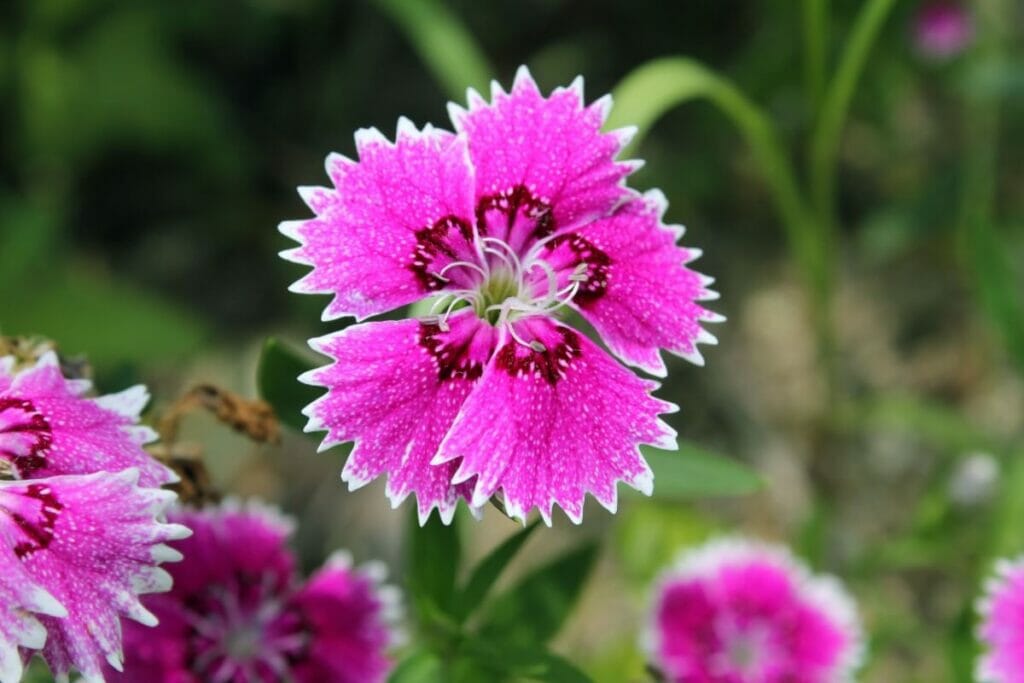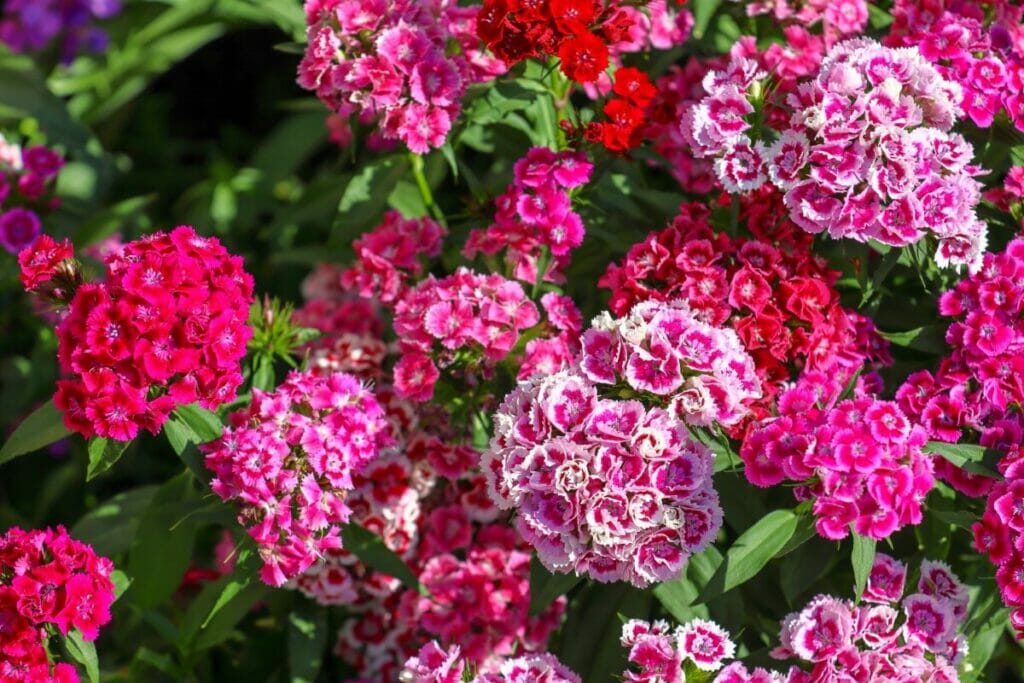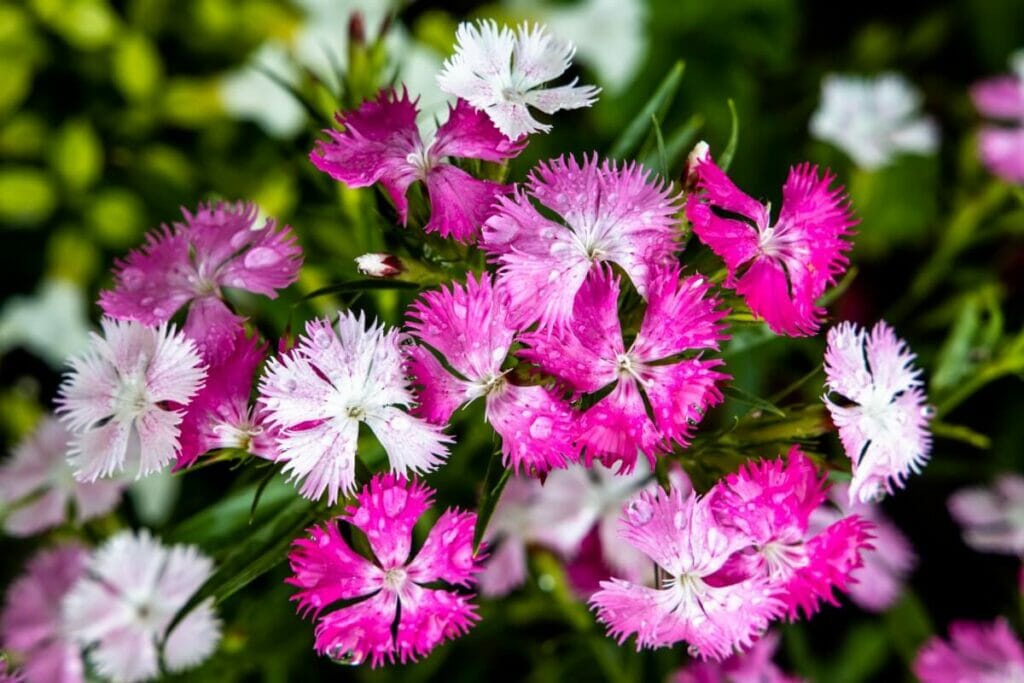Garden Pinks (Dianthus Chinensis) Plant Care Guide
Dianthus chinensis, commonly known as Chinese pinks, adds an eye-catching splash of pink, red, and white color to the garden. Long prized by gardeners across Asia and Europe, Chinese pinks are associated with love and divinity. In my opinion, they certainly make a divine addition to flower beds and borders, attracting butterflies and hummingbirds with their colorful, serrated blossoms. Here, I’ll take you through everything you need to know about how to grow and care for Dianthus chinensis flowers at home.

Key Takeaways:
| Botanical Name: | Dianthus chinensis |
| Also Known As: | Chinese Pink, China Pink, Indian Pink, Rainbow Pink |
| Hardiness Zones: | USDA Zones 6 to 9 |
| Flowering Months: | Late spring through early fall |
| Growing Difficulty: | Low maintenance and easy to grow |
| Type of Plant: | Annual in cooler regions, biennial or tender perennial in warmer regions |
| Light Requirements: | Partial to full sun, with afternoon shade preferred in hot weather |
| Temp & Humidity: | Thrives in cooler climates and well-drained soil |
| Watering Needs: | Requires good drainage; water when the soil feels dry |
| Soil Preferences: | Average, dry to medium soil with a neutral to alkaline pH (6.0-8.0) |
| Feeding: | Add a slow-release fertilizer to the soil when planting, or apply a balanced fertilizer every 6-8 weeks |
| Growth Expectations: | Up to 2.5 feet tall and 1 foot wide |
| Toxicity: | Foliage is toxic to humans and pets; may cause skin irritation and vomiting |
How to Grow Dianthus chinensis

Best Locations to Plant
D. chinensis is an excellent choice for the middle of borders, thanks to its maximum height of 2.5 feet and attractive, narrow foliage. You may also grow Chinese pinks in garden beds and containers. If you live in a warmer climate, just be sure to provide protection from the afternoon sun.
Chinese pinks work well in several garden types, including rock gardens, butterfly gardens, cottage gardens, and even drought-tolerant gardens.
Best Times to Plant
When planting from seed, sow D. chinensis seeds indoors 6 to 8 weeks before the last frost date. Transplant seedlings or purchased plants outdoors from one to two weeks before the last frost date.
If you sow seeds directly in the landscape, wait until after the last frost date has passed.
Growing from Seed vs Nursery Plants
When growing Chinese pinks from seed, sow outdoors only after the danger of frost has passed (in many temperate regions, April or May). Cover with a very light layer of soil.
If you sow under shelter, you can start in late winter. Seeds take one to two weeks to sprout at 65 to 70 degrees F. Transplant outdoors close to the last frost date. In many regions, this will be in May.
The Best Soil
D. chinensis grows best in very well-drained soil. They tolerate occasionally dry soil and dislike wet feet. China pinks will grow in various soil types, including sandy, clay, and loamy. They prefer a neutral pH to slightly alkaline, from 7.0 to just over 8.0.
How to Plant
When sowing Dianthus seed in early spring, cover with a very thin layer of soil. The plants need light to germinate.
When planting from nursery pots in late spring, dig a hole that’s the same depth and twice as wide as the root ball. Gently place the plant in the hole and fill it with soil. You may add some slow-release fertilizer at planting time if you choose. Water thoroughly.
Light Preferences
Chinese pinks thrive in full to partial sun. In hot areas, offer afternoon shade.
Temperature & Humidity
D. chinensis grows best in cooler temperatures and well-drained soil. It tolerates occasional dry conditions.
How to Care for Dianthus chinensis

Watering
Water Chinese pinks when the soil feels dry. In most cases, water once a week during the growing season. Chinese pinks prefer a less-frequent deep soak rather than more frequent light watering.
Fertilizing
If using nursery plants, add a slow-release fertilizer to the soil when planting. Otherwise, apply a balanced fertilizer, such as 20-10-20, every six to eight weeks during the growing season.
Pruning & Cutting Back

Deadhead a spent flower from D. chinensis to help prolong the blooming period. If flowering declines, you can shear and trim the plants to encourage more blooms.
Propagation
Chinese pinks may self-sow if you leave a few flower heads to go to seed. You may also propagate from stem cuttings.
Cut non-flowering stems just under a leaf joint. Trim lower leaves, leaving four to five leaves at the top of the stem. Dip stem bases in a rooting compound, then place them in pots with light potting soil. Water the pot, then place it in a plastic bag. Cuttings will form roots in four to five weeks.
Overwintering
Chinese pinks may be annuals or biennials, depending on the climate zone. To encourage plants to survive the winter, protect the plants from drying winds and freezing temperatures.
After flowering ends, trim plants, removing any spent blossoms and about one-third of the top growth. If in containers, cluster them together or place them along a south-facing wall. Place a frost blanket over plants when temperatures drop below 40 degrees F.
Common Problems & How to Treat Them

D. chinensis may be susceptible to rust and crown rot, especially when planted in poorly draining soil. Prevent rust by providing enough ventilation and proper drainage. Remove foliage that looks brown or rusty, and treat plants with copper oxychloride.
When planted in humid spots, powdery mildew may appear on leaves. Treat with benomyl fungicide. If planted in shady spots, watch out for snails and slugs. Use a snail/slug bait.
Though Chinese pinks can tolerate some drought and occasionally dry soil, signs of underwatering include drooping leaves. Overwatering or too much shade may lead to leggy plants.
Essential Tools
Chinese pinks don’t like wet feet, so a moisture meter is helpful. Use gloves when handling plants, as the leaves are known skin irritants.
Wrap Up
Chinese pinks add bright color, spicy fragrance, and interesting texture — thanks to their serrated petals and lane-like leaves — to borders and beds. These lovely plants offer a long bloom time and low maintenance. Just be sure to plant D. chinensis in a well-drained site with just enough sunlight and protection from the afternoon sun when temperatures climb.
Madison is a writer and editor with a Bachelor’s degree in History and Political Science. She writes and photographs for various online and print publications in the gardening sphere and is the author of the book The Next-Generation Gardener.

